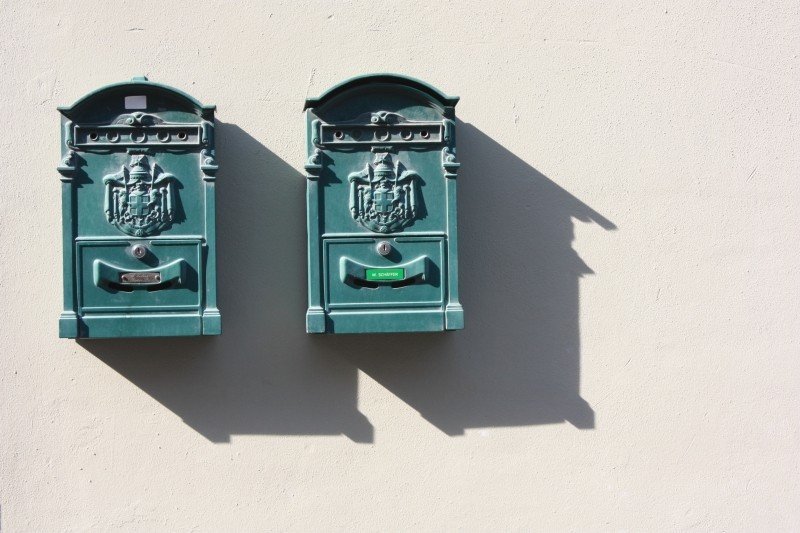
Today’s guest post is by Christina McDonald (@Christinamac79), author of The Night Olivia Fell.
An email list is your secret weapon for selling books—it is a direct connection to your reader. But when I got my first book deal, I had no audience, no author Facebook page, and no email list. I knew I needed to build awareness to give my book the best chance to succeed. Here is my step-by-step guide to how I built my email list to 6,000 subscribers in one year.
1. Draft a plan
The first thing I did when I got my book deal was sit down and come up with a plan to build an email list. Coming from a digital copywriting background, I knew that social media sites like Facebook and Twitter were good for brand building, but not for getting people to buy. Buying happens through an email list. I also knew I would need to provide people with a benefit to get them to sign up. Here’s what I decided to provide:
- Quarterly newsletters
- Interviews with authors
- Free book giveaways
2. Get the tools you need
Once you have a plan to grow your email list, you’ll need to get the tools to implement it. The tools are:
- An email marketing tool. I use Mailchimp because it’s cheap and easy. Mailchimp is where I collect the names and emails of people I communicate with. It allows me to send emails to everybody on my list at one time.
- Website. I use WordPress, which offers free accounts at WordPress.com.
- A Facebook author page. This is different from a personal page. The main reason to have this is to run ads, but it also helps you build your audience and connect with readers.
- Prizes and books to give away. I decided to give away free books signed by the author as a way of encouraging people to sign up for my email list. If you can’t get an author to give you a signed copy, you can still buy a copy and give it away.
3. Set up the giveaway page
This should be a very simple page with one goal—to get people to sign up for the newsletter. The design should include a headline with the main benefit, some additional text explaining how the giveaway works, and a way for them to enter. Try to get an image of the book cover if possible.
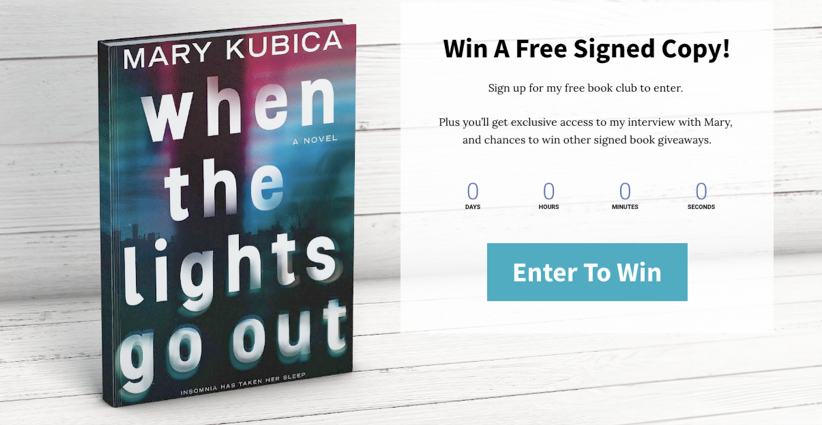
4. Create an email capture form
Create a form using your email marketing tool (such as Mailchimp) to capture names and email addresses and add them to your email database. I make clear on this giveaway page that subscribers are signing up for my book club to enter to win the book. The Enter To Win button takes the reader to a form asking them to enter their name and email address. (See note on GDPR at the end of this article.)
Here’s a great article on how to create an email capture form using Mailchimp; it includes information on GDPR as well.
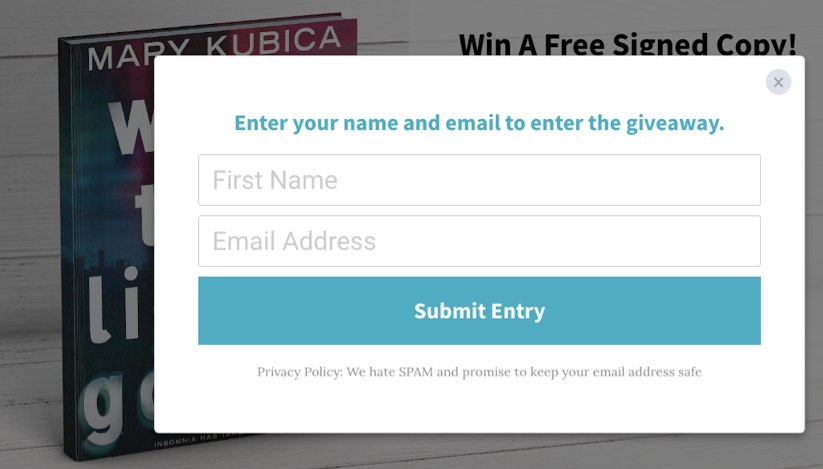
5. Create a thank-you page
Once someone submits their information, you can choose where to direct them. Rather than a generic thank you page, I take users to a page that encourages readers to like my Facebook page, as this is where I announce the winner. Because I announce winners on my Facebook page, I get a number of email list subscribers also following me here. At this point I also give them access to my interview with the author of the book as free, extra content.
Here’s what my thank you page looks like:
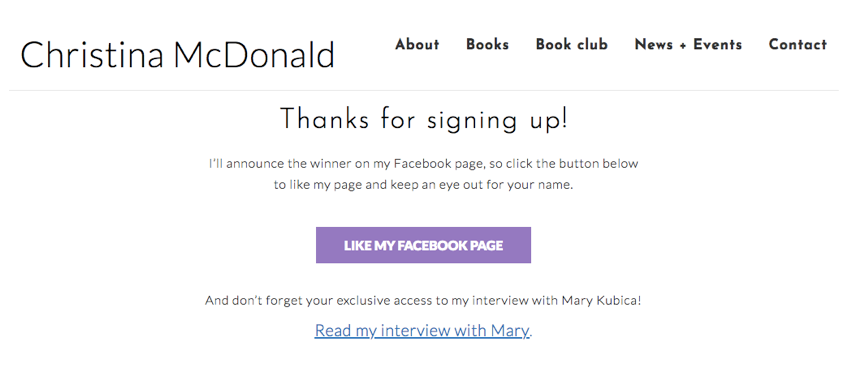
6. Get signups through Facebook advertising
I used Facebook advertising to drive people to my giveaway landing page. There’s a lot of depth and complexity to Facebook advertising, but an easy way to start is to just boost your posts. Even if you have zero followers, you can target others with a Facebook account based on their interests. For example, you can target fans of similar authors in your genre.
- Create your post. To start, create a post on your Facebook author page announcing you’re giving away a free signed book. Include the link to your giveaway signup page where readers can enter their name and email. Once the giveaway is finished, you’ll then choose a winner from your email list.
- Keep your design and copy simple and clean, with some benefit-driven copy on it. I did the 3D book cover image in Photoshop, but you can get this done on Fiverr.com or if you’re happy with a simple 3D cover, just use DIY Book Design.
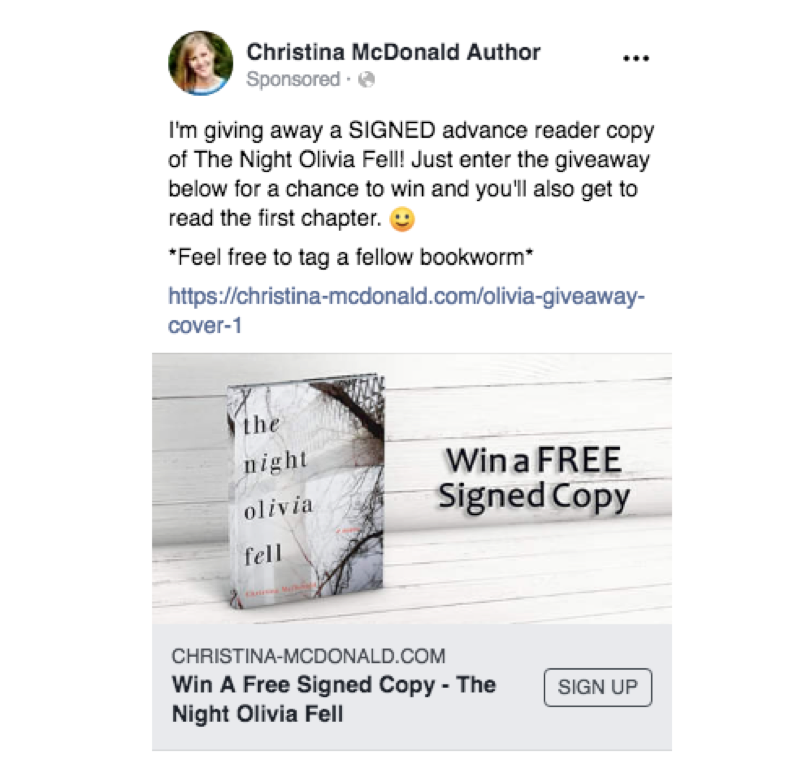
- Boost your post. Once your post is up, you’ll see a blue box on the bottom right hand corner called ‘Boost Post’. When you click this you’ll see a number of options for boosting your post, including people you want to target, your budget, how long you want it to run, and how you’ll pay for it. This is a great way of getting audience engagement to develop brand awareness and grow your following.
- Spending and frequency. You can spend as little as $5 to boost your post. I started out spending $20 on a week-long boosted post, and I did one giveaway a month for the first few months. When I got more comfortable using boosted posts, I started doing two giveaways a month, and increased my budget to $50. The more money you spend, the more people see the boosted post, and the more signups you’ll get. Make sure you check your boosted post at least daily to be sure you’re getting results and not wasting your money.

- Targeting your audience. Getting the right target audience for who will see your post is really important. It’s also a really cheap way of getting results. When choosing who you want to see the boosted post, it’s better to have a smaller, targeted audience, rather than making the audience as broad as possible. Narrow your target audience so they like one interest AND another. For example, they like Goodreads AND a certain author.
- I measured my results by how much I paid for each subscriber. I checked how many subscribers there were in Mailchimp and divided the amount I spent for the ad by the number of new subscribers gained. I typically spent 25 cents per new email on my list.
Once you have a bit more experience with boosting posts, you’ll want to move on to using Facebook ads. These are a little more complicated, but they allow you to refine your targeting and give you more control over the audience you show your posts to.
Tip: I didn’t find Facebook ads worked to get people to directly buy, but getting them to sign up for a freebie was fairly cheap and easy. Once they were on my email list I could then foster a relationship, which made it easier to generate pre-orders and sales.
7. Start sending your email newsletter
Now that you have subscribers, you need to implement an email marketing strategy. This includes continuing content, author interviews, and book giveaways to keep readers engaged and grow your email list.
I designed a newsletter using Mailchimp’s free email designer. I send my newsletter out quarterly, but you can choose how often you want to do one.
My newsletter includes upcoming book giveaways, competitions I’m holding, and recommendations for books I’ve read. I also choose one subscriber each newsletter issue to win one of the books I’ve recommended in my newsletter. Again, everybody likes a benefit, and it helps ensure they’ll engage with the newsletter and open it to find out if they won.
In addition to designing my newsletter in Mailchimp, I also design a similar page on my website. It takes more time, but the benefit is I can share it across social media, and it is mobile ready so people can read it on their phones.
Here’s an example of a newsletter I sent out.
In today’s highly competitive publishing space, we must all be much more than just authors. No matter what publishing route you take, to be a successful author you’ll need to promote yourself and your book. Building an email list fuels your platform and helps you develop direct, long-lasting relationships with your readers so you can sell more books.
A Note About GDPR
Depending on where you live and the audience you’re targeting, you may need to abide by General Data Protection Regulation (GDPR) rules when you run contests or giveaways. GDPR is a set of rules designed to give EU citizens more control over their personal data. Here’s a plain-English guide to staying on the right side of the law.
Christina McDonald is the author of domestic suspense novel The Night Olivia Fell, published by Simon and Schuster and HarperCollins (UK). An author, journalist and copywriter, Christina has worked for companies such as The Sunday Times, Dublin, The Connacht Tribune, Galway, Expedia, USAToday.com, Travelex, and Pearson Publishing. Originally from Seattle, WA, she holds an MA in Journalism from the National University of Ireland Galway, and now lives in London, England.

Some excellent new tips here. I like #5 where you encourage the subscriber to link to a Facebook page and ask for a like and can see how that would be effective.
Thank you! It’s good to have different platforms and different media to connect with readers!
While I’m thankful for this advice, it seems to only apply to someone who already has a book deal, hence the reason people would visit your website in the first place. Any tips for how you can build as your writing, prior to that deal since most agents want you to have a platform?
Hi John, I got a book deal but had no platform. I had a website but nobody was looking at it, I had 0 followers on social media and 0 on an email list. As soon as I got the book deal I realized I needed to get to work on building my platform. I leveraged the names of other authors with the giveaways to get people onto email lists, and built a name for myself and a following that way. But the people seeing my Facebook ads had never heard of me before. I would suggest starting building your platform before you submit manuscripts because any platform is better than none.
[…] Christina McDonald: How to Grow an Email Newsletter Starting from Zero […]
Great advice! I’m bookmarking the page for if (when?) I get a book deal. I wonder how you choose the winners… 🙂
I use a google random number generator so it’s completely fair! ????
Hi great stuff. How do you hook up with other authors for the giveaways? Thanks!
Hi Shirley, I contact them directly through social media or email. Sometimes they don’t respond, sometimes they do. As you become more established and your blog/newsletter/website better known, more authors will agree to partake. If you can’t get a signed copy from an author, you can always buy a copy yourself and use it as a giveaway (it just won’t be signed). It’s still a giveaway and it’s still useful to build your list! 🙂
A good way to get a signed book, and support your local indie bookstore, would be to attend a bookstore reading of a book launch by an author you admire, where she or he signs books purchased by attendees.
That’s a great idea!
[…] Some writers use email newsletters to increase sales. Christina McDonald tells us how to grow an email newsletter from scratch. […]
This is FANTASTIC. I hear all the time. “build your email l’ It’s essential.”, but no one, no one ever tells you how to do it.
Thank you so much for such a wonderful post.
You’re very welcome! 🙂
I am concerned about the “Win” in the “giveaway”. Almost all states have laws against gambling and lotteries other than state sponsored ones. They don’t want any competition.
Hi Steve, I can’t give any legal advice, given that laws are different from state to state, country to country. If you’re concerned, maybe run your contest design and terminology by a legal professional.
This article was so helpful. I’m an indie author who’s trying to grow my audience. I’ve wanted to make a newsletter for a few months now but was deterred from doing so because I have no followers. I’ll definitely be using these to create a newsletter.
Best of luck, Caitlyn! I can’t wait to hear how it goes!
[…] Newsletter Growth Tips | Jane Friedman […]